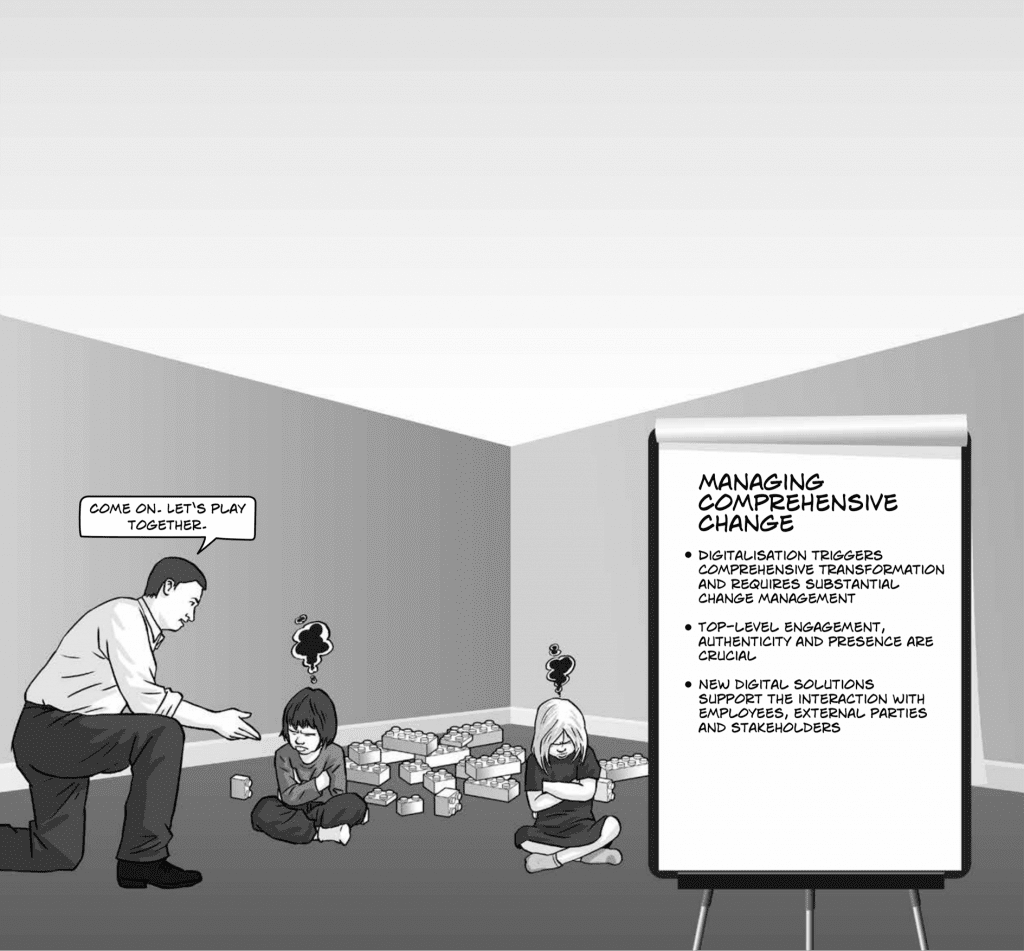The digital transformation triggers massive change in the enterprise: interactions with customers, as well as those with new partners in the digital ecosystem, are established on a completely new basis. New business models for the enterprise are created and must be implemented thoroughly. New operational models in the enterprise must support these business models, usually requiring the new business processes and data usage to bridge historical departmental boundaries. All this triggers comprehensive change for the organisation. The challenges accompanying such change must be mastered carefully.
The organisation has to embrace this change and will struggle with the process; the more comprehensive the change, the tougher the struggle.
Employees’ fears, uncertainties, even their objections must be taken very seriously. Such reactions to change are normal and should be addressed in a constructive manner. At the extreme, however, such concerns might turn into resistance and even attempts at sabotage of the digitalisation initiative, requiring decisive action. But even where such negative developments are not encountered, change management during the digital transformation must have utmost priority.
Change must be managed from the top.
With a mission that is so decisive for the company’s future, the CEO and the CDO – and ideally the full Executive Board together with the next management level – must explain the rationale for change and its purpose, mobilise people, evangelise about the new digital world and create factual and emotional buy-in. We all know the ‘no pain, no gain’ paradigm. However, there is also a ‘no gain, no pain’ paradigm: employees will not wholeheartedly undergo vast change unless they understand the rewards to be reaped, the promising future of the digital world.
The CDO must describe the future rewards of the, at times, tough digital transformation programme to the organisation and create buy-in and support, generating enthusiasm for the changes ahead.
When bringing the digital transformation to the organisation, two fundamentally different approaches can be taken to conducting the transformation programme: the CDO can on the one hand decide to start the digital transformation approach in a sandbox environment; on the other, he or she can opt for a top-down approach.
With the first approach, the CDO can create a shadow organisation, which is designed using the principles of the desired target state, but at a small scale.
In such a sheltered environment, the proof of concept of core features of the new digital business model are demonstrated, prior to either the expansion of the sandbox by absorption of other traditional business functions, or the transfer of successfully demonstrated sandbox concepts into the traditional line organisation. If the digital transformation results in multiple innovation advancements, the sandbox can become an incubator for elements of the novel business model.
While the sandbox/incubator approach can be preferable from a change management perspective, the alternative scenario might also prevail, for example when there is a ‘burning platform’ that compels the enterprise to act in a struggle for survival: the digital agenda can also be imposed top-down onto the existing organisation with the CDO steering the transformation. Very strong leadership is necessary to make this second approach a success, but it might be demanded by the enterprise’s situation.
In any case, the digital transformation must be mandated from the top.
A bottom-up approach using the innovative power of small cells should only be used to drive the innovative spirit.
Implementation of such ideas, however, must always be sponsored by and directed from the Board, as it is, they who will transform the very organisation. In addition, the incubator should not begin with elements of digitalisation that only matter to unimportant parts of the business, deferring a move to the core of the company’s value creation to a later point in time. Success in the digital transformation of core parts of the business must be demonstrated early on in order to create buy-in and overcome obstacles. To execute change management in practice, a framework such as the 8 Steps of John P. Kotter{1],[2] or Kurt Lewin’s Change Model[3] should be chosen.
Furthermore, a dedicated team has to be assigned to cope with the numerous tasks inherent in such an undertaking.
Effective change management programmes exhibit certain common characteristics. Credible, enthusiastic engagement from the top is necessary, demonstrated by the extensive presence of senior executives in front of the employees, explaining the rationale, allowing employees to challenge the approach taken and engaging in a dialogue. Communication is key, and the importance of effective communication in a time of comprehensive change must not be underestimated. It is vital to be honest and open about the change.
The change programme has to have absolute priority for the enterprise’s management and time must not be wasted – the changes should be implemented with determination and speed, once the path towards the digital world has been identified and agreed. However, the viable speed of change does depend on the non-digital status quo and the organisation’s capacity to implement change. In this respect, the digital transformation does not differ much from other transformations. The only difference is that the sheer scope of change to the enterprise’s status quo can easily exceed what the enterprise has experienced in the past. Even more attention needs to be given to change management, and success should not be taken for granted once the new business model has been validated. These are simply the essential conditions for launching the transformation.
This section concludes with an interesting aspect of the pervasive availability of new digital solutions: they also give us unprecedented new means of change management,[4] allowing us to handle the fast-paced continuous change of the digital transformation.
Novel digital communication approaches meet employees’ expectation of interaction.
Communication experiences can be personalised, just-in-time feedback given, progress demonstrated transparently. Using digital tools, useful feedback regarding the transformation programme can also be easily communicated from employees to the management.
Traditional hierarchies can be sidestepped, empowering the individual and giving them a broad audience.
Such approaches build empathy, community and shared purpose. Digital communities within and beyond the enterprise get created with the purpose of actively shaping the transformation process itself. Last, but not least, modern e-learning techniques allow for an effective spread of knowledge about the new digital world.
_____
[1] Kotter, J. P., Rathgeber, H.: ‘Our Iceberg Is Melting: Changing and Succeeding Under Any Conditions’, Macmillan, 2006.
[2] Kotter, J. P.: ‘Leading Change’, Harvard Business Review Press, 1996.
[3] Lewin, K.: ‘Frontiers in group dynamics’, Human Relations, pp. 5-41, 1947.
[4] Ewenstein, E., Smith, W., Sologar, A.: ‘Changing change management’, McKinsey, 2015.




